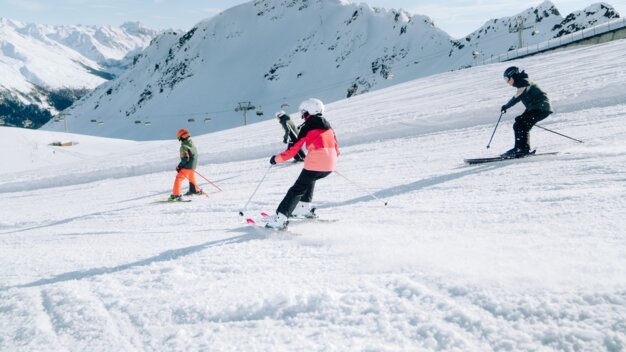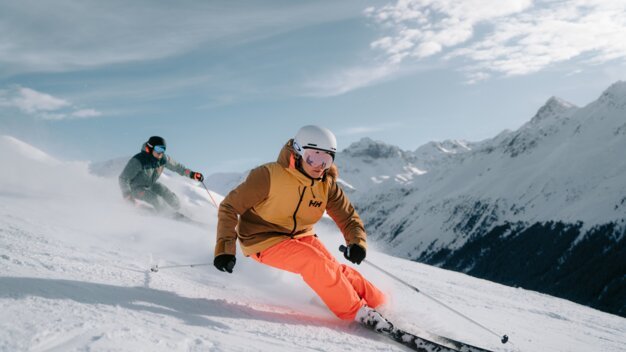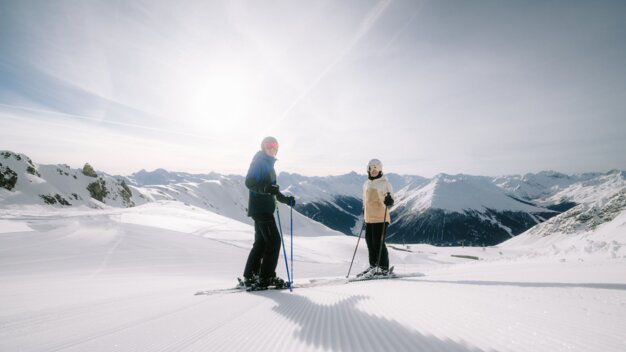
Most winter sports enthusiasts have skied blue, red or even black ski runs before. You probably also know that blue means “easy”, red means “intermediate”, and black means “expert”. The colour coding of the slopes is mainly based on their gradient. In general, however, everything revolves around one topic: safety.
When it comes to symbols and unusual colours, things can get a little trickier: What does a black diamond, a green circle, or a yellow slope mean, for instance? And are the difficulty ratings the same in every country? We talked to our winter sports experts and summarised what you need to know about slope difficulty levels.
Why are there slope difficulty ratings for skiers and snowboarders?
First things first: The colours serve as a rough guideline for winter sports enthusiasts. The difficulty ratings only contribute to a safe experience on the slopes if you combine them with a healthy (self-)assessment of the situation.
Depending on skill level, fitness, and current snow and weather conditions, every skier and snowboarder needs to decide for themselves: Am I able to ski this slope, or should I rather try another, easier descent? Can I ski this slope safely, or am I endangering myself and others? You certainly don’t want to end up in pickle – or worse, mortal danger. And plaster casts and crutches didn’t make it onto the list of this season’s ski fashion trends either.
The following factors should influence your decision:
- tiredness & exhaustion
- wind, rain or snowfall
- cold weather & ice
- fog & reduced visibility
How do ski runs receive their colours?
Ski runs are colour-coded based on the motto: the steeper, the more difficult. At least that’s the case in most Alpine countries. For this purpose, the average gradient of the terrain on the respective section of the slope is determined with the help of special measuring devices.
However, please keep in mind: A blue slope can quickly turn from an easy into a difficult one when it’s icy. Weather conditions do not change the colour of the run, so they must always be taken into account before you hurl yourself down a descent. Permanent structural changes, on the other hand, can be a reason to change the colour coding of a slope.
Skiers should know about the following difficulty ratings
It is actually the gradient and not the difficulty that’s the deciding factor for the colour of a ski run. If you’ve ever gone skiing in the Alps, you’re probably familiar with the common difficulty ratings. However, if you’d like to review them, we’ve listed them below.
Good to know: Colour-coded ski runs are regularly checked (at least daily), groomed and secured against avalanches.
Blue slopes – easy
All ski runs with a maximum gradient of 25 per cent are marked blue. Short off-piste sections are excluded. Blue ski runs are ideal for beginners, children and returning skiers. They are good for learning and practising basic skills and are usually relatively wide.
Red slopes – intermediate
The average gradient range of a red ski run is between 25 and 40 per cent. Red runs are usually slightly narrower than blue ones and ideal for advanced skiers and snowboarders. Many winter sports enthusiasts use red runs to prepare for steeper terrain or to finetune their carving technique. However, short turns are also very enjoyable on intermediate runs.
Black slopes – expert
All slopes with a gradient of more than 40 per cent are marked black. For beginners, skiing on black ski runs is dangerous. Those who are experienced in short turns and fast-paced skiing will have a lot of fun on them, though. Carving, on the other hand, is not advisable on steep slopes. Are red slopes still a challenge for you? Then you should stay away from black runs.
Other ski run colours
Green:
- very easy, flat slopes, and practice slopes (without exact definition) – not common in Austria
- in France and North America: slopes with a gradient range between 6 % and 25 %
- in Scandinavia and Spain: practice slopes with a gradient of up to 16 %
Yellow, orange or red dashed line:
- ski routes and other itinerary runs: marked and secured, but not groomed
- require experience and confidence in your own skiing ability
- are usually checked irregularly
- exception: In France, ski routes are officially considered “controlled areas”.
Off-piste terrain:
Everything outside the marked ski runs is off-piste terrain – often also called backcountry. These areas are not checked, groomed or secured. They should therefore only be used by experienced skiers and snowboarders.
Difficulty ratings abroad
Other countries = other colours and symbols. This isn’t true for the Alpine region (which shares a common system), but it is for other countries in Europe as well as North America. We have summarised the most important “codes” for you (percentages = gradient).
Sweden and Norway
- green: up to 16 %
- blue: up to 27 %
- red: up to 47 %
- black: more than 47 %
- double black: extremely difficult
North America
- green circle: 6 to 25 %
- blue square: 25 to 40 %
- black diamond: more than 40 %
- double black diamond: extremely difficult, e.g. with narrow bends and lots of moguls
Note: Colour-coded ski run levels in the North American system are only ever in relation to other runs within the same ski resort. This means that a green circle can stand for different levels of difficulty in different ski areas.
What do you do if a ski run is too challenging?
What if suddenly you find yourself at the top of or in the middle of a ski run and you can't go any further? Too steep, too icy, too bumpy. Your strength is leaving you. There’s poor visibility. And all of a sudden, panic strikes …
If you happen to end up in this situation – turn around if possible and take the lift down. If you don’t have this option, you can use the sliding technique and slide down slowly along the edge of the slope. If you’re having problems with poor visibility, we recommend stopping at the next hut.
INTERSPORT Rent tip
According to the general rules of conduct of the International Ski Federation (FIS), every skier and snowboarder must ...
- ... observe the slope markings, closures and other signs.
- ... refrain from skiing off-piste, in wooded and protected areas.
- ... be able to stop, turn and move within the ambit of their vision.
- ... adapt their skiing and snowboarding to their ability and the prevailing conditions on the mountain as well as to the amount of downhill traffic.
Particular caution is advised in this respect in fog and snowfall, not least because of the reduced visibility. Fresh snow, for instance, can be the cause of bumps on otherwise even slopes and requires more effort when skiing.
In windy and cold conditions, your body uses more energy to keep warm than in higher temperatures. A factor that should not be underestimated! Last but not least, remember: The snow conditions on a ski run can change dramatically throughout the day, so reassess the situation every time you decide to ski a certain run!
PS: You can rent the right equipment for all weather and snow conditions at INTERSPORT Rent. Find a shop at your holiday destination right away!










